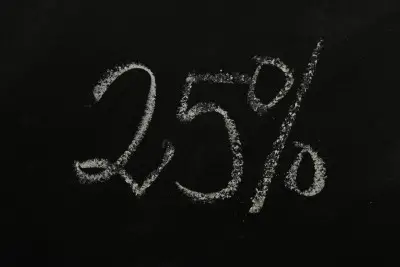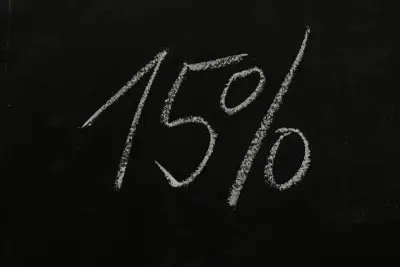
You’ve probably used percentages before. “I got a 94% on the last test!” or “I tipped our waitress 22% because the service was so good.” Shopping at the mall, you’re often bombarded with signs like “25% off all sweaters” or “an additional 20% off all sale items.”
Intuitively, you likely understand percentages. In this article, we’ll delve deeper into percents and learn some strategies for solving percentage problems.
| The word percent means “per 100.” |
We use percents to express numbers as parts of a whole. For example, 25% is equivalent to the ratio 25/100. Fractions that don’t have a denominator of 100 can be converted to a percent by setting up a proportion.
Example (Fraction To Percent)
Express the fraction 3/4 as a percent.
Solution
Set up a proportion. The variable x represents the percent.
3/4 = x/100
Cross multiply:
4x= 300
Divide both sides by 4:
x=75
Hence, the fraction 3/4 is equivalent to 75%.◾

Example (Decimal To Percent)
Convert the decimal 0.125 to a percent.
Solution
It’s relatively easy to convert a decimal to a percent. We could use the previous method and set up a proportion. Since the decimal is taken to the thousandth place, change the decimal to the fraction 125/1,000. Set up the proportion and follow the same procedure as in the above example:
125/1,000 = x/100
1,000x = 12,500
x = 12.5
Hence, the decimal 0.125 is equivalent to 12.5%. ◾
Perhaps you noticed – there is a much simpler way to convert a decimal to a percent! We can move the decimal point two places to the right, and that’s it!
Examples (Decimals To Percent – Two Decimal Places Right Rule)
The following decimals are easily converted to percents by moving the decimal point two places to the right.
- 0.56 = 56%
- 0.007 = 0.7%
- 1.25 = 125%
Notice, in the third example the percent is greater than 100%! How does that happen? How can a part be greater than the whole? Let’s investigate a bit further.
Example (Percents Greater Than 100%)
Jamie invested $500 twelve years ago in a tech stock. When he checked the rate of return over the twelve year period, he learned it was 108%. How much money does he have now?

Solution
When a number increases by a percent greater than 100, we can think about it as increasing by its full amount and then some. For example, if the initial investment of $500 increases by 108%, it goes up by 100% of $500 which doubles the investment to $1,000, then there is an additional 8% increase.
To find 8% of $500, multiply the decimal equivalent 0.08 by 500 to get $40. So, the investment increased by $500 + $40 = $540. Jamie now has a total of $500 + $540 = $1,040. ◾
Tipping
In the US, it’s customary to tip restaurant servers for their work during your meal. The suggested tip amount is 15% to 20% where 15% is for average service and 20% is for good service. These numbers have been changing since the pandemic so now people are frequently tipping over 20% for exceptional service.

You may have seen suggested tips on a restaurant receipt – they do the calculations for you and they suggest tipping amounts that are over 20% as well as the standard 15% or 20%. It’s up to you how much to tip!
If your receipt doesn’t show you the different tip amounts, it’s easy to calculate tips in your head so you don’t have to pull out your phone’s calculator!
Note: some people insist that it’s proper to tip on the before tax amount of the bill while others tip on the after tax amount. While it is technically correct to tip on the before tax amount of the bill, it’s still up for debate. If you want to be more generous, tip on the post-tax amount of the bill.
Example (Percents For Restaurant Tips)
Jerome and his family have just dined at a restaurant where they received good service. The bill comes to $128 including taxes. Jerome wants to leave a 20% tip. How much should he give the server?
Solution
To calculate the 20% tip, we can work with 10% and double it. It’s quite easy to calculate 10% of a number by moving the decimal point one place to the left.
10% of $128 = $12.80
Now, to get 20%, we simply double $12.80.
A 20% tip would be:
(2)(12.80) = $25.60.
If you’re paying by cash, you can round up to the nearest dollar to avoid giving the server a bunch of coins! In this case, Jerome tips $26.
Let’s say you really want to minimize the amount of math you do and aren’t in the mood for doubling $12.80 to calculate 20%. You could round $12.80 to $13, then double that to get the $26 total tip.
Be careful of rounding down because then you’re no longer giving the server a 20% tip. ◾
Example (Percents For Restaurant Tips)
Hayley dines solo at a casual restaurant. She decides to leave a 15% tip on her bill of $23.20. How much should she give her server?
Solution
Once again, we can make our lives easier by working with 10% of the total. Move the decimal point one place to the left to find 10%.
10% of $23.20 = $2.32
Now, we need to calculate 5% so we can add the 10% amount to the 5% amount to get 15%. Since 5% is half of 10%, divide $2.32 by 2:
2.32/2=1.16
Finally add the two amounts together:
2.32+1.16=3.48
Hayley should leave a tip of $3.48. If she wants to avoid leaving coins on the table, she could round up to $4, which will be a little more than 15%. If she rounds down to $3, which we would normally do in math class since we’d look at the tenth place (4) to determine how to round, she would be tipping less than 15%. ◾
Percent Increase/Decrease
Consider the following problem:
Leeya just started working out. On Wednesday, she used the treadmill and walked at a rate of 3.4 miles per hour. On Thursday, she increased her walking rate on the treadmill to 3.6 miles per hour. By what percent did her walking speed increase from Wednesday to Thursday? Round answer to the nearest tenth of a percent.

Solution
This problem is a typical percent increase problem. The general strategy for solving a percent increase or decrease problem is:
- Find the difference between the new value and the original value.
- Divide this difference by the original value.
- Convert the decimal to a percent by multiplying our result by 100.
Following these steps we obtain:
- Find the difference between the new value and the original value.
3.6 – 3.4 = 0.2
- Divide this difference by the original value.
0.2/3.4= 0.0588
- Convert the decimal to a percent by multiplying our result by 100.
0.0588*100 = 5.88
Rounded to the nearest tenth, Leeya’s walking speed increased by 5.9%. ◾
Example (Percents For Store Discounts)
Kylie buys a pair of blue jeans that were discounted. Kylie wasn’t aware of the sale when she made the purchase and was pleasantly surprised at the register because the original price was $78 but Kylie only paid $66.30. What was the percent decrease (discount amount)?

Solution
Follow the same strategy as our first problem.
- Find the difference:
66.30 – 78 = -11.7
Note: because this value is negative, we know we’ll have a percent decrease.
- Divide -11.7 by the original price of $78.
-11.7/78 = -0.15
- Multiply the decimal -0.15 by 100 to convert to a percent.
-0.15*100 = -15%
The percent decrease (discount amount) was 15%. ◾
| Word of Caution #1 When finding the percent increase or decrease, always make sure you divide by the original value, not the new value. This is one of the biggest mistakes students make when working with percents. |
Example (Compounding Percents For Discounts)
Theo is in a clothing store that’s having an end of the season 20% off everything sale. Underneath all of the sale signs are smaller signs that say if you use your store credit card, you’ll get an additional 10% off. Theo decides to buy a shirt that was originally priced at $100. Theo plans to use his store credit card so he quickly reasons, “I’ll get 30% off of $100, which means I’ll only pay $70!” When he pays at the register, Theo sees the final price is $72. Assuming there is no sales tax and that the cash register is correct, what is Theo’s mistake?
Solution
This situation comes up a lot in retail sales. The issue is the additional 10% off applies to the discounted price, not the original price. If Theo wants to correctly determine the final price, he should reason as follows:
Calculate the first sale price. Theo gets 20% off of the original price, meaning he pays 80% of $100.
Sale price before the additional discount:
(0.80)(100)=$80
Since Theo pays with the store credit card, he gets an additional 10% off. It’s easy to calculate 10% of 80 – it’s another $8 off the price.
The final price is equal to the sale price minus the additional discount:
80-8=72
The cash register is correct – the final price is $72. ◾
| Word of caution #2 Be careful when working with percents that are less than 1%. For example, 0.5% actually is equivalent to ½% but students frequently think 0.5% is the same as 50%. Why? Students usually know that 50% is equivalent to the decimal 0.5. Since we’re starting with the percent and we want to convert it back to a decimal, we move the decimal point 2 places to the left, giving us 0.005 as the decimal equivalent of 0.5%. |
There you have it! Hopefully, this article provides you with some techniques for working with percents, especially when you need to do the computations in your head!
I hope you found this article helpful. If so, please share it with someone who can use the information.
Don’t forget to subscribe to our YouTube channel & get updates on new math videos!
About the author:
Jean-Marie Gard is an independent math teacher and tutor based in Massachusetts. You can get in touch with Jean-Marie at https://testpreptoday.com/.


